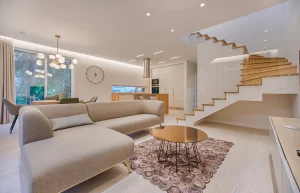Smart furniture means that you can turn potentially cold and angular spaces into warm, intimate spaces – from studios to office spaces, where lack of space does not preclude functionality. From built-in bed-cum-sofa combos to smart tables, smart furniture offers a seamless combination of style and function.
Smart furniture of the highest calibre can even communicate with other home automation systems, which makes the user experience more intuitive and facilitates cross-navigation within the home.
Enhanced Comfort
It provides the aesthetic and makes life easy maximising comfort and and can help people preserve their health. An encouraging point is that in the broad concept of ‘smart ‘furniture’ is ‘smart living’, making everything easier. ‘Smart’ sofas with a USB charging port or ‘smart’ chairs using UV light to sanitise your phone helps create a beautiful and life-like environment. Taking the concept of smart living into the ultimate application, chairs can use UV light to sanitise your mobile phone! ‘Smart’ furniture truly helps people to overcome real life issues and makes daily life easy.
Because smart furniture is fully automatable, users have ample opportunity to select the customisation and personalisation options at their disposal. For example, recliners allow users to tailor the contours of the seating in accordance with biometric profiles, and users of mattresses can programme mattress firmness and temperature adjustments using smartphone applications – all this so that one can be assured of getting maximum value for his or her investment by putting it to optimal use.
Seamless Integration
Seamless integration means that you’re able to bring in systems or applications with a minimal amount of disruption to the way we are working and our software environments so information can flow between systems to increase productivity and efficiency.
Get savvy with smart furniture that makes you more comfortable, connects you to your world and looks cool. Get high-tech seating with features that let you enhance lumbar support with your smartphone and fall asleep with the touch of a button.
Minimise your footprint and maximise your space with small-space design innovations that multiply the uses of multifunctional and transformative spaces. Subtle in form and functional in fashion, coffee tables flip to desktop chairs, cabinet beds feature hidden compartments with tech bays and more in sleek and streamlined design innovations.
Enhanced Convenience
Another example of smart furniture is sofas that are embedded with some high-end technologies to make your life easier and more comfortable, such as ones with in-built Bluetooth speakers to play music without the need for additional speakers, some also provide USB battery charging ports to let you refresh the power of your electronics devices quickly.
In fact, personalisation is fast becoming the norm for furniture today. Thanks to smart furniture, settings can adapt to the unique body types of each person – a trend that feeds into the rising demand for flexible solutions, which are fit for the dynamic office and home environments of today; for businesses, this means easier decision-making for clients than ever before.
Health & Wellness
Smart furniture involves the use of devices in a forward-thinking way that will make life easier for users in the future. For example, by installing wireless charging technology in coffee tables, people can quickly recharge their devices even when they do not have their charger with them.
Other innovations include finger unlocking and LED lighting that enables both increased functionality while allowing the generation of the optimal ambiences. Stakeholders can do so by developing furniture built specifically around habits of their users. Like many other fixtures and outfittings within a fixed space and time, machine learning (ML) and artificial intelligence (AI) can output different varieties of furniture.
For instance, an ergonomic smart chair might automatically mould itself to the user’s posture to optimise comfort levels (based on information and settings for each individual) to reduce or avoid back pain so as to boost productivity. Suppose the smart chair is able simultaneously and successfully to alleviate back pain and boost productivity.
Space-Saving Solutions
Space restrictions mean that, if you want your home to be functional – effective – as well as attractive, smart furniture is sometimes essential. Fortunately, many multifunction furniture pieces can be reconfigured quickly, fitting into your changing needs; many multipurpose pieces allow you to rearrange the layout as your requirements alter.
Space-saving solutions can also look good. Gone is the need to rely on bulky, drab, outdated 1960s-style furniture; for every drowsy format there now exists a multitude of space-saving pieces for any colour or texture of your home scheme.
One can find dozens of clever furniture solutions including bookshelves-turned-dining tables or cabinet beds that you can never notice during the day as they leave plenty of floor space for other activities. Buy one of these clever furnishings and they will help you maximise your living property and minimise clutter.
Digital Transformation
In addition to creating opportunities for automating time-consuming tasks, smart furniture will help users personalise their life experiences, such as the aforementioned adjustable desk that can be lowered and raised automatically, helping reduce neck and back muscle strain.
Smart furniture is often energy efficient as well – adjustable RGB light devices allow their users to adjust the light colours without consuming too much energy.
Smart furniture can also help you keep yourself healthy – some health-monitoring features you can find in smart furniture can track your sleeping patterns and the way you sit in your office chair. That’s not all – smart beds and chairs can have features like back massagers or a cooling massager for your feet!



